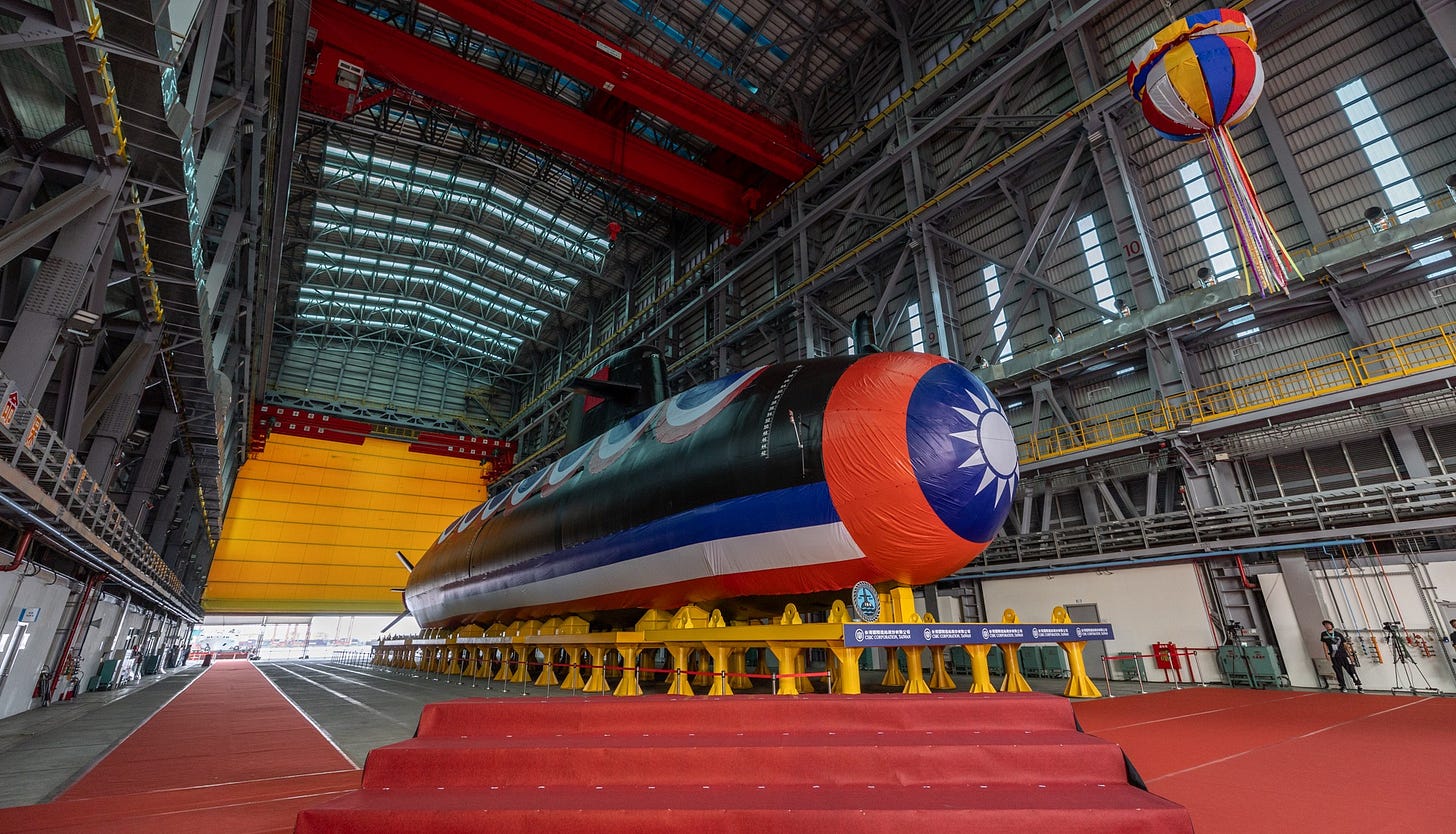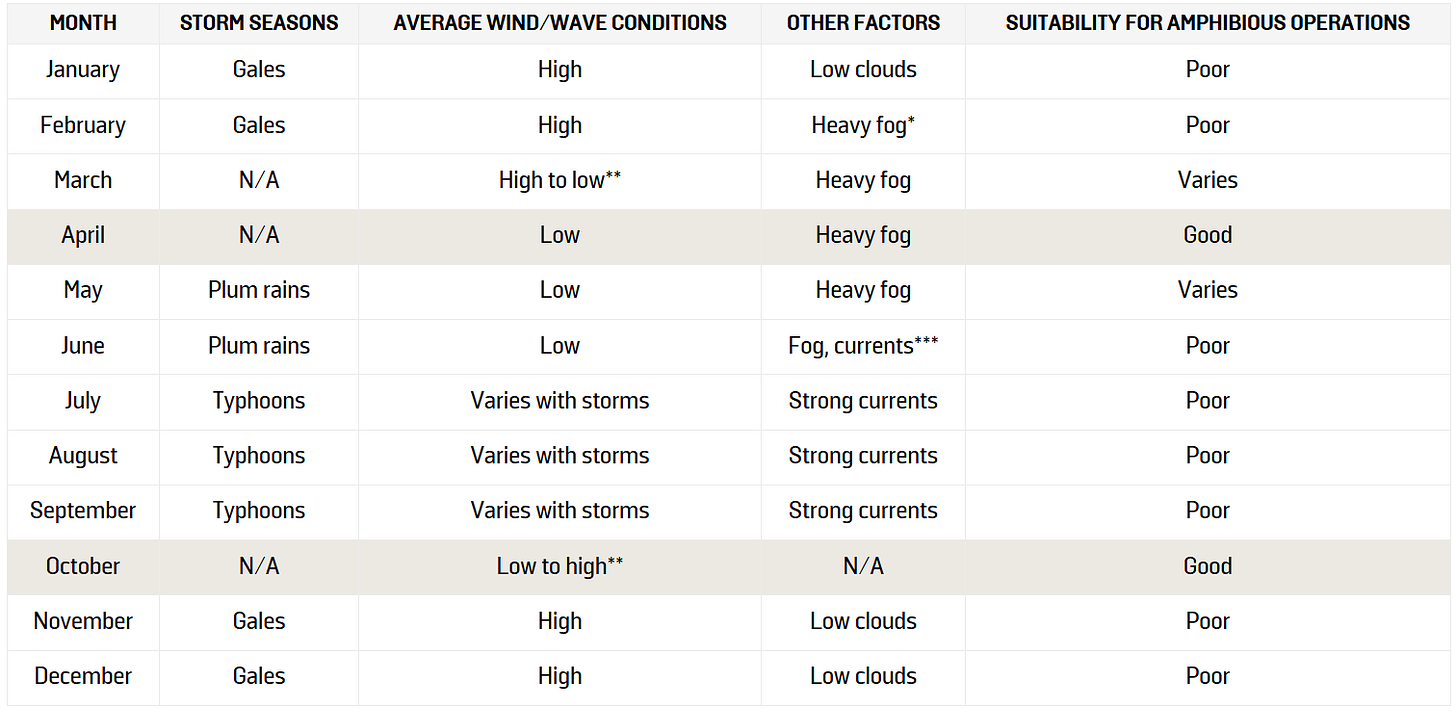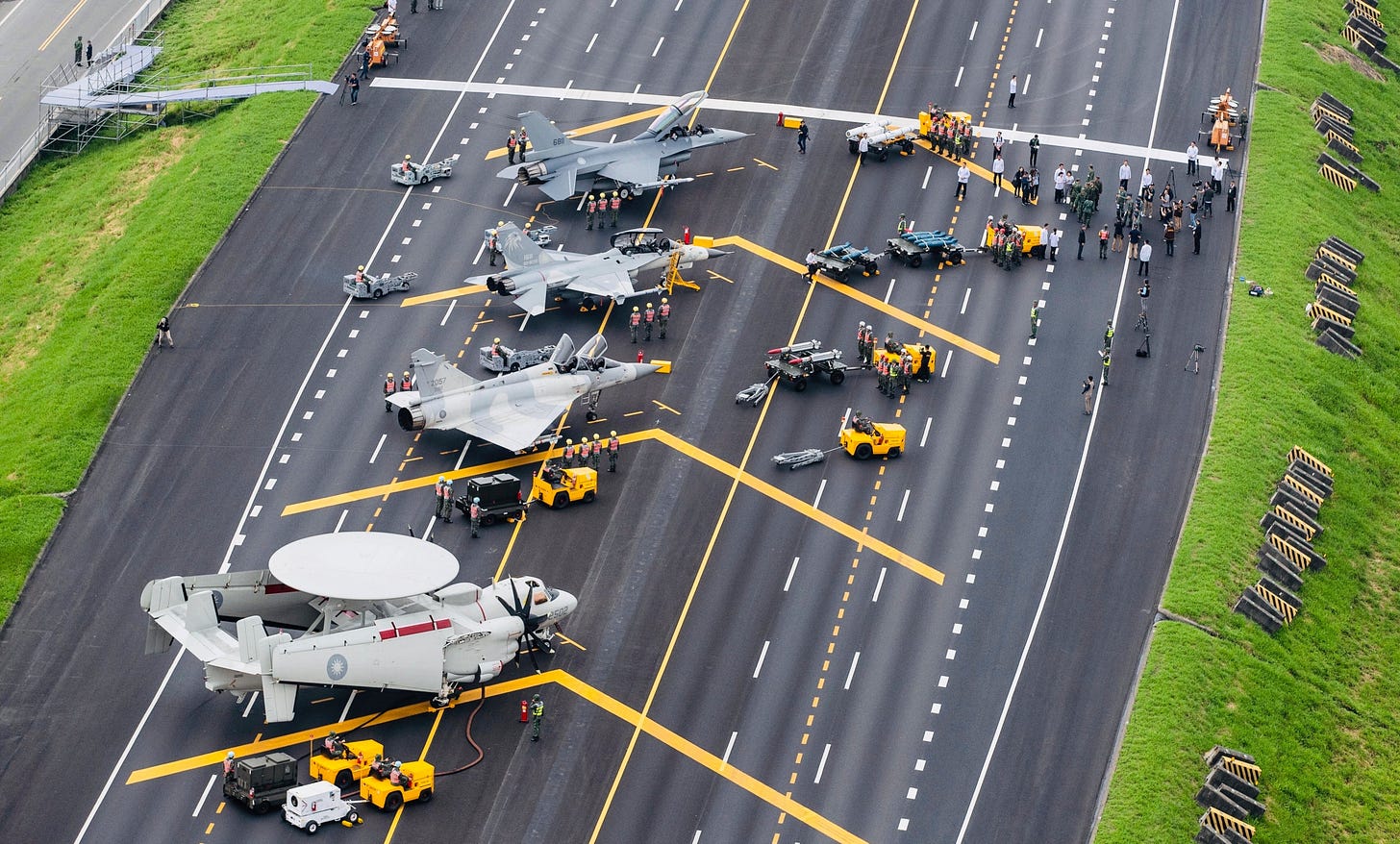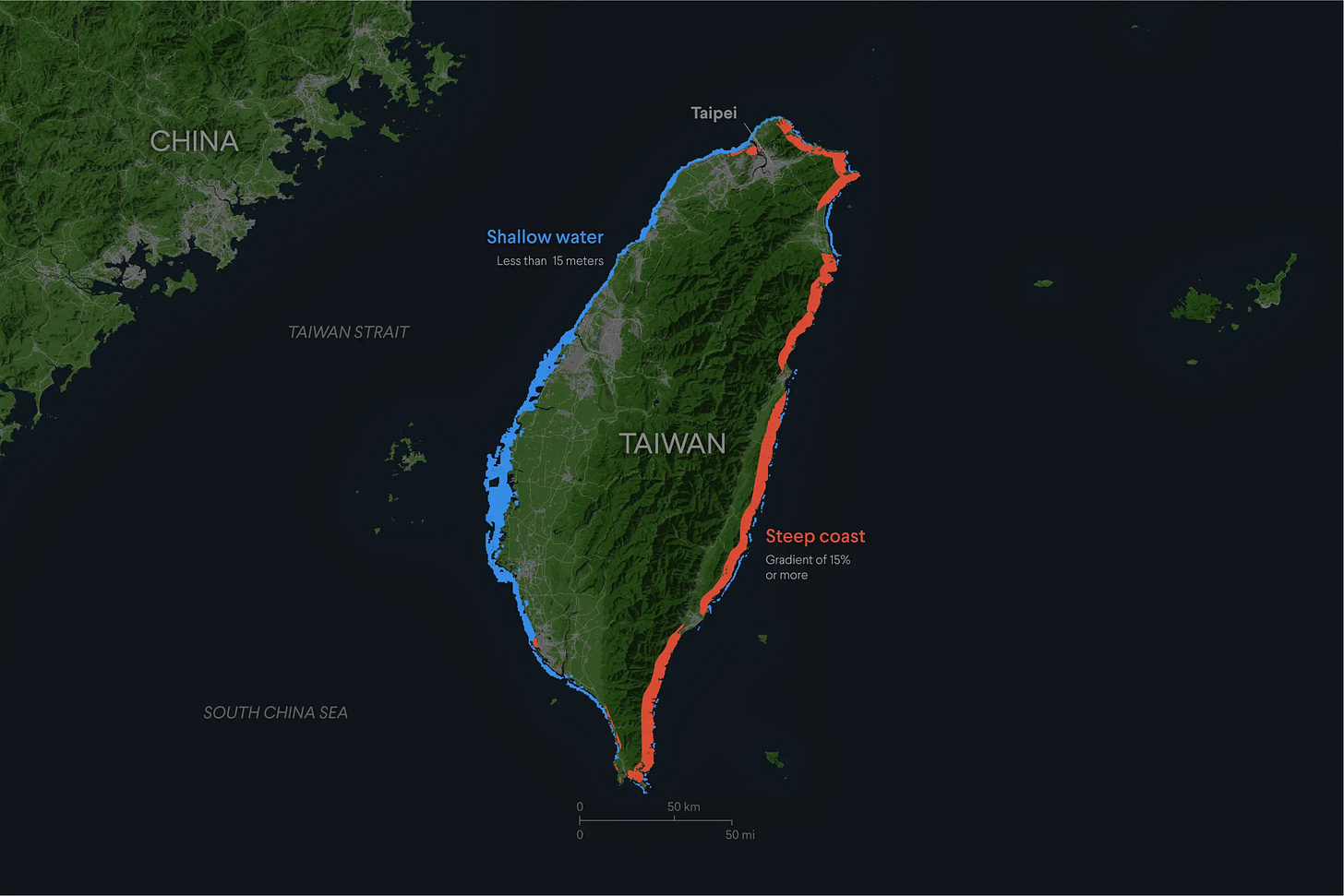How China Would Struggle To Invade Taiwan
Why crossing the Taiwan Strait will be the most difficult military operation in modern history.

For more than seventy years, the threat of invasion has loomed over Taiwan: so long that many Taiwanese have come to assume it may never happen. Under China’s President Xi Jinping has this threat grown ever more likely.
At the heart of Taiwanese defence strategy is the principle of asymmetric warfare. Lee Hsi-Ming, then-Chief of General Staff, coined the term “Overall Defence Concept” (ODC) in the late 2010s. ODC is built on two premises: firstly, China will fulfil Xi’s dream of unifying Taiwan, and secondly, a recognition that Taiwan and China are not equally matched.
In terms of military spending, China dwarfs Taiwan, with a 2025 budget of US$222 billion compared to US$19.7 billion. This amount comes to roughly 2.5% of Taiwan’s GDP — a fair amount compared to many European nations who themselves are rearming for a possible Russian conflict. When viewed comparatively, however, this proportion falls short of that allocated by countries confronting similar existential threats. Israel, for instance, spent 4.5% of its GDP in 2022 while Ukraine spent 3.4% in 2021 (a year before both conflicts started respectively). For active personnel, the People’s Liberation Army (PLA) outnumbers the ROC Armed Forces by a staggering factor of 12, although Taiwan has more in reserves.
Given the disparity, ODC redefines winning the war as preventing the PLA from successfully staging an invasion and exerting control over Taiwan. Much like a porcupine, the underlying strategy is not offence (for instance, a pre-emptive strike). It is to make an invasion so painful, so prohibitively expensive, that China will think twice to materialise any attack plans.
High as the mountains, deep as the sea
For any invasion to start taking place, the PLA must cross the Taiwan Strait. The Taiwan Strait is 128km (80 miles) at its narrowest point, and much wider if embarkation points are considered. Unlike Russia who waltzed into Ukrainian soil with approximately 50,000 soldiers on the first day of its invasion, an amphibious assault is exponentially trickier. China will need to attack on a scale comparable to the Allied landings on Normandy, where 156,000 troops were transported across the English Channel on D-Day alone.
But crossing over to the island isn’t that simple. The Taiwan strait is inundated with typhoons during July to October, and suffers from plum rains during early summer. In winter, icy gales and heavy fog take over. Hence, the invasion must happen in two four-week windows, in either April or October.

Even if the Chinese managed to successfully cross the strait, they face a dearth of suitable landing spots. Most experts recognise just 14 viable beaches to land on, and even then, they are bordered by mountains, cliffs, or dense urban infrastructure. Furthermore, most of these beaches are shallow water beaches. This means the PLA would need to anchor ships far from Taiwan’s coasts, and transport equipment to the shores through shallow water — making them a vulnerable target to Taiwanese artillery.
Assuming that the PLA crossed the strait unimpeded, and landed on the beaches without trouble, they would need to face a third geographical barrier: mountains. Taiwan is comprised of a heavily-forested mountain ridge that runs down the middle, stretching for 395km (245 miles). To the west of this ridge lie large sprawling cities: Taichung, Hsinchu, Chiayi, Tainan and Kaohsiung. The capital, Taipei, sits in a fortified bowl, ringed by forested mountains. Chinese soldiers will have to fight their way through dense apartment blocks, which will slow progress to a crawl.
Russia took more than 9 months just to take the city of Bakhmut, which some analysts regarded as the bloodiest battle in Europe since WW2. For comparison, Hsinchu, one of the closer major cities to Taipei, has six times Bakhmut’s pre-war population, and almost three times the area.
Crouching tiger, swimming dragon
First off, what does an amphibious invasion need? It needs almost complete air superiority. This is something that China is very confident of achieving, and for good reason. The PLA Air Force (PLAAF) fields approximately 2,100 fighter aircraft, including fifth generation jets like the J-20. Meanwhile, Taiwan operates around 400 fighters, the most capable of which (F16 and Mirage 2000) being outdated by a whole generation.
The main enablers of an invasion, however, are the amphibious assets. In this regard, China is lacking landing ships, which are needed to offload tanks, supplies and troops. As of writing, the PLA Navy (PLAN) has roughly 12 large landing ships (Type 075 and 071), and 54 medium landing ships (Type 072 and 073). If all of these are somehow deployed at the same time, they can carry roughly 1700 average-sized amphibious vehicles, and 25,000 troops in total. In reality, however, the actual number is far fewer, as some ships will be under maintenance or repair.
That’s where the idea of using commercial and ferry ships come in. In 2016, China passed the national defence law, which requires Chinese shipping companies to provide assistance in military operations. Combined with military transport, Binkov’s Battlegrounds, a military educational channel, estimated China today is plausibly at little under half the capacity of the D-Day landings — at 70,000+ troops. Once a beachhead is secured, China is expected to land at least half a million soldiers within the first month of the war.
Turning the tide
One contribution of D-Day’s success was misdirection. British intelligence diverted the majority of the German attention to Pas-de-Calais, away from Normandy. As a result, Normandy’s beaches were heavily fortified, but lightly garrisoned. China’s PLA simply will not have this luxury of surprise. Firstly, the invasion must happen in either April or October. Secondly, modern intelligence will know of an imminent invasion months in advance. Easton (2017) suggested that Taiwan will know for certain more than 30 days before the first missiles are fired. Publicly visible proxies will be obvious as well: calls for blood drives, field hospitals established near embarkation points, and PLA implementing a nation-wide stop loss.
All these will give Taiwan ample time to prepare: moving command infrastructure into fortified mountain bunkers, reposition the PLAN to safer ports, detain suspected Chinese operatives, scatter sea mines all over the ocean, and activate Taiwan’s 1.6 million reservists. As battle looms, each beach will be transformed into a hellscape of booby traps. A Chinese military report describes:
“PLA anticipates that minefields at sea would be followed by beach obstacle systems, emplaced in the shallow waters that begin 300 to 600 feet offshore. These are designed to entangle, rip apart, and incinerate small landing boats full of troops. Taiwan’s planned obstacle systems are believed to make use of moored nets, clamshell traps, log cages, steel spikes, sunken truck containers, and mines. The military is believed to have stockpiled 53 gallon oil drums for wartime beach defense. Just prior to invasion, these would reportedly be filled with 220 pounds of TNT, mixed with gasoline, and chained three or four feet below the surface, where they would wait menacingly for Chinese landing craft to touch them off. Each is estimated to have a lethal blast radius of 100 to 150 feet, killing with shock and shrapnel, and leaving flaming oil slicks in their wake.”
Source: Zhao Feng (ed.), The Taiwan Military’s 20 Year Transformation [台军20年转型之路] (Beijing, National Defense University Press, 2015), p. 89.
We haven’t even considered the active deterrence Taiwan will shell out. Mobile coastal defence cruise missiles (CDSMs) and harpoon coastal defense systems (HCDSs) will bombard troops and vehicles as they arrive on shore. Subsonic and supersonic missiles (HF-2 and HF-3 respectively) will skim the seas, striking ships as far out as 100km. Taiwan has purchased 29 HIMARS, which can hit targets as far out as Fujian province, on the other side of the strait. High up in the air, F-16s launching from fortified, nuclear-hardened mountain hangars will unleash Harpoon missiles to take out the remaining transport ships.
Taiwan’s first domestically produced Hai Kun-class submarine, and her planned seven sisters, will hunt down Chinese ships relentlessly with MK-48 heavyweight torpedoes. Sink enough of the landing or supply ships, and the invasion collapses — either at the beach, or further inland as landed forces starve.

Is it really that simple?
Traditionally, it is accepted that a defending force has a 3:1 advantage over an attacker. We see this in the Russo-Ukrainian War, where Ukraine has defiantly fought back against a numerical advantage. However, it is guaranteed that China will attempt to level the playing field. Preceding the actual invasion, PLA’s Rocket Force will unleash an opening salvo of missiles that scream towards Taiwanese airfields, communication hubs, government offices, and air defence systems. Chinese special forces or sleeper agents will attempt to assassinate Taiwan’s top leadership. Those new Hai-Kun submarines we were talking about? Chinese’s own fleet of nuclear attack submarines will be hunting them down. The Stanford Review describes a chilling scenario:
In a coordinated strike, Chinese special forces land throughout Taiwan. Phone lines, telecommunication networks, and energy supplies are sabotaged. The entire nation descends into darkness. They assassinate prominent politicians, raid military bases, and cripple Taiwan’s infrastructure network. Missile strikes across the island target Taiwanese naval, air, and army bases. Billions of dollars worth of flashy weaponry the Taiwanese government has bought–tanks, attack helicopters, and warships–are reduced to piles of twisted steel in hours. China activates its “fifth column” in Taiwan as local politicians, military officers, and criminal organizations sow chaos and confusion throughout the country. Some entire units stop answering to Taiwanese high command. Some politicians declare themselves to be in charge of the government and promise peace talks with China. Average conscripts succumb to the belief that “it's better to be red than dead” and lay down their arms.
Day breaks. A Chinese flag flies over Taipei 101. Chinese ships full of PLA soldiers land in Taiwanese ports, completely unopposed. Tanks roll throughout the streets of Taiwan. Small bands of fanatical resistance exist, but they are doomed to fail. Within months, China stamps them out. And Americans wake up to a new world, having had completely zero time to react.
Source: https://stanfordreview.org/the-illusion-of-taiwanese-strength/
Tanner Greer, director of the Center of Strategic Translation, believes that Taiwan can only hold off the PLA for two weeks after the first landing. If Taiwan receives no help from her allies — be it the U.S., or even Japan — then Taiwan is doomed to fail, eventually. The extent of help matters in Taiwan’s longevity. A direct American military intervention will see the invasion dead in the water within days. A more lackadaisical approach (perhaps the U.S. offers satellite targeting or arms purchase) will see Taiwan struggle much more.
Finally, it’s worth recalling that despite the heroism of D-Day, the Allies suffered relatively light losses: 4,400 killed out of roughly 150,000 who landed. No matter the extent of American involvement, the PLA will likely face a significantly higher death ratio. Beijing appears willing to accept such costs. Can Taiwan say the same?
“Special military quarantine”
I think the more likely outcome would be a Cold War-esque naval blockade. As an island nation, Taiwan is extremely dependent on imports. Food self-sufficiency stands at just 30%. Almost 98% of Taiwan’s energy needs are imported — oil from Gulf states, coal and natural gas from Australia. The safer option for China is simply to starve Taiwan out of its energy supplies. Its reserves for gas and coal are estimated to last 11 and 39 days respectively, which in turn powers Taiwan’s formidable semiconductor industry.
According to modern international law however, a naval blockade constitutes an act of war. When used to starve a nation’s civilian population, they become a war crime. President JFK famously chose to phrase America’s blockade of Cuba as a “naval quarantine” to avoid the formal implications of a state of war. Russia’s “special military operation” invasion of Ukraine was a flimsy euphemism to obfuscate the severity of the war. China could do something similar to prevent the United States from a military response.
“留岛不留人”, a common phrase about the outcome of an invasion, roughly translates into “leave the island, not the people”. This entails an invasion so destructive that it effectively renders Taiwan a scorched-earth territory, leaving most of its residents either dead or fled. There is a reason why this saying is a minority view in China now. Viewed transactionally, Taiwan is more valuable to the Chinese in its status quo. For all its saber-rattling, perhaps China has no true plans to attack at all.




